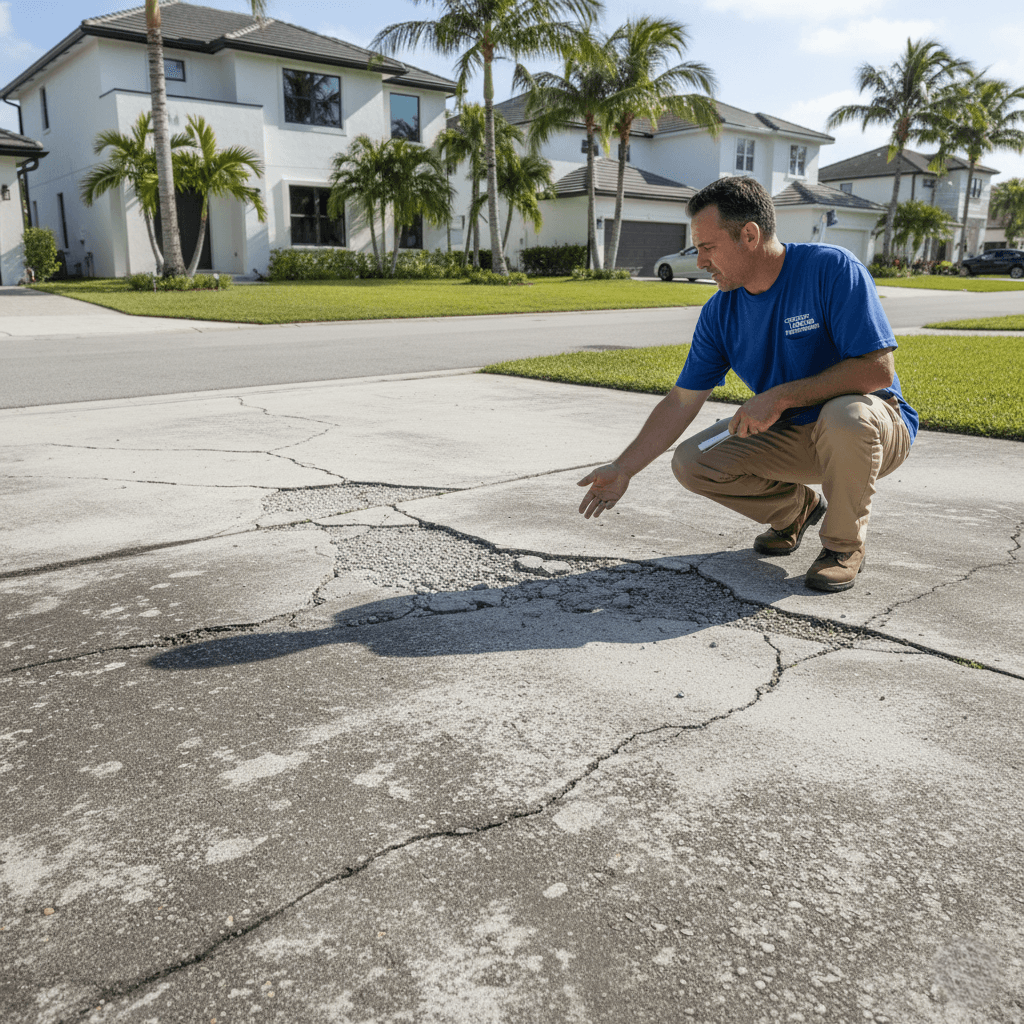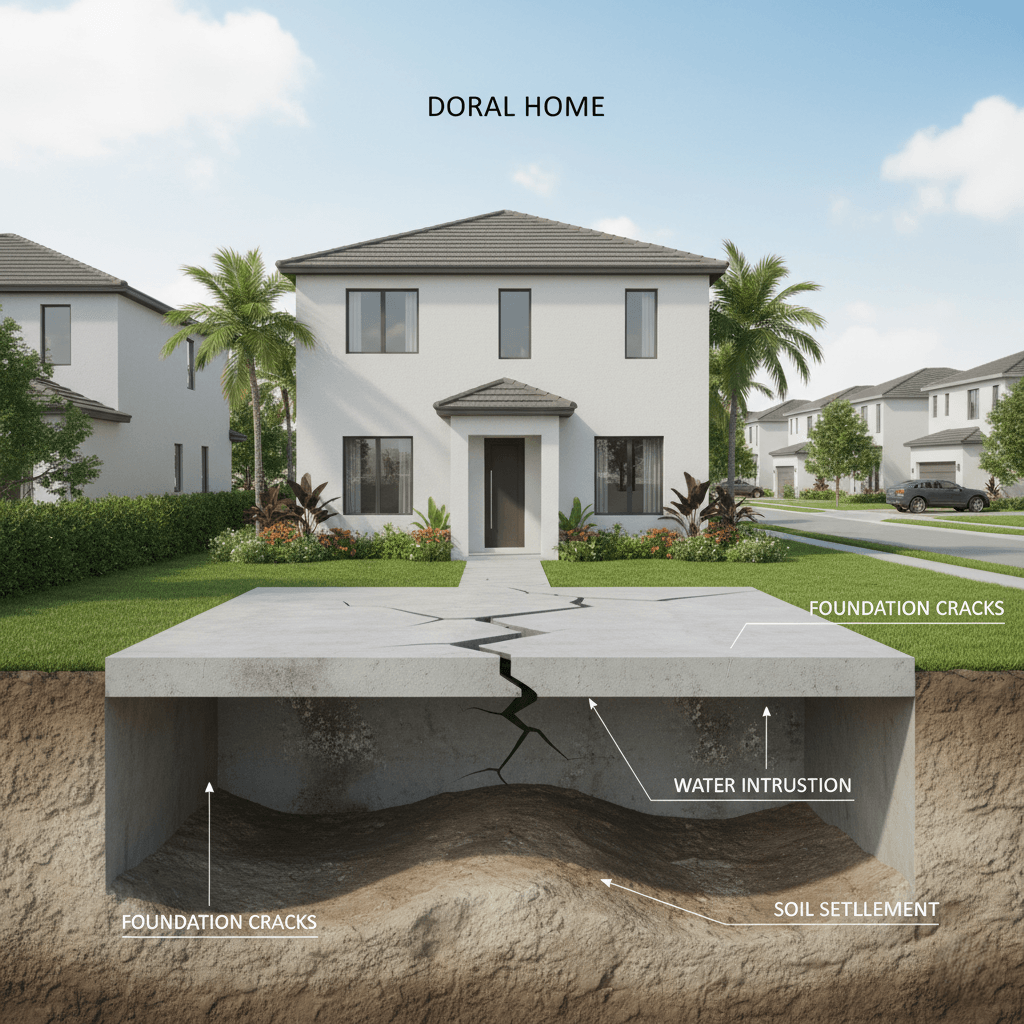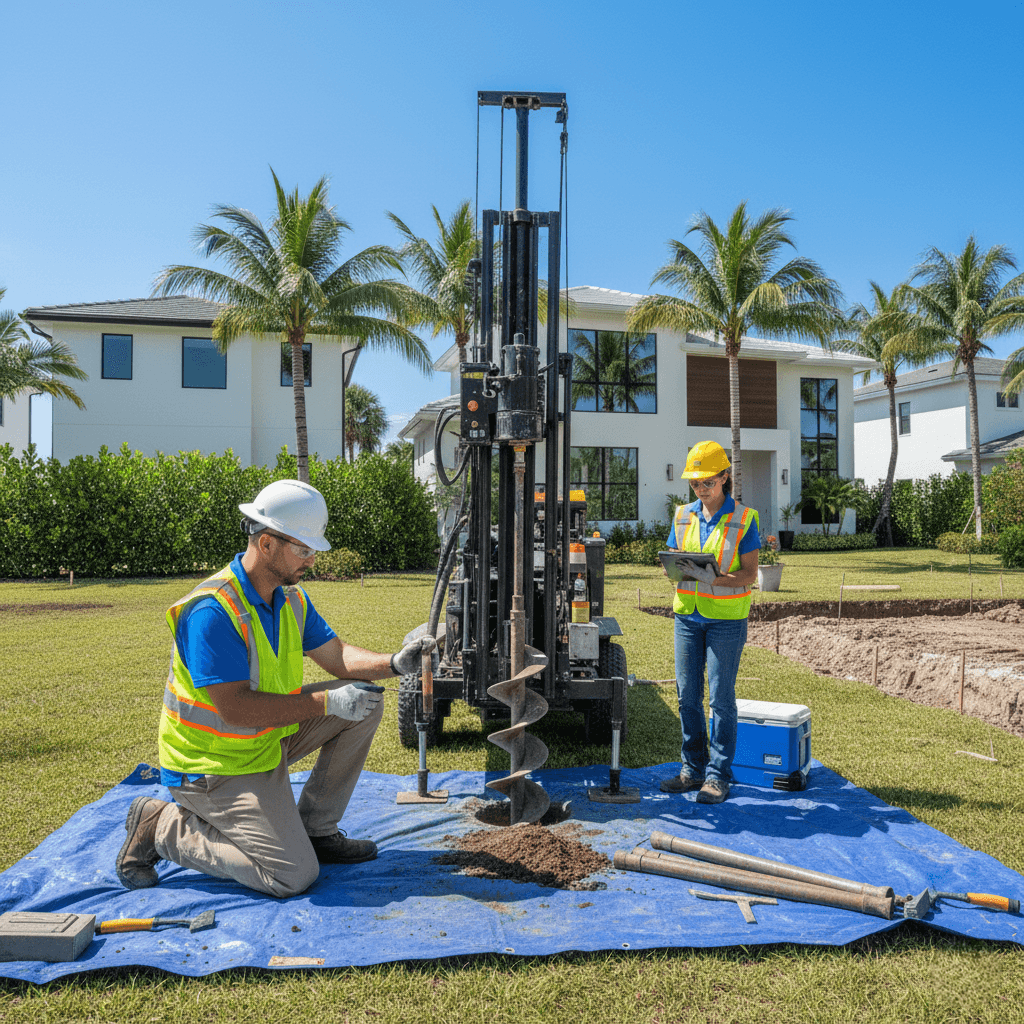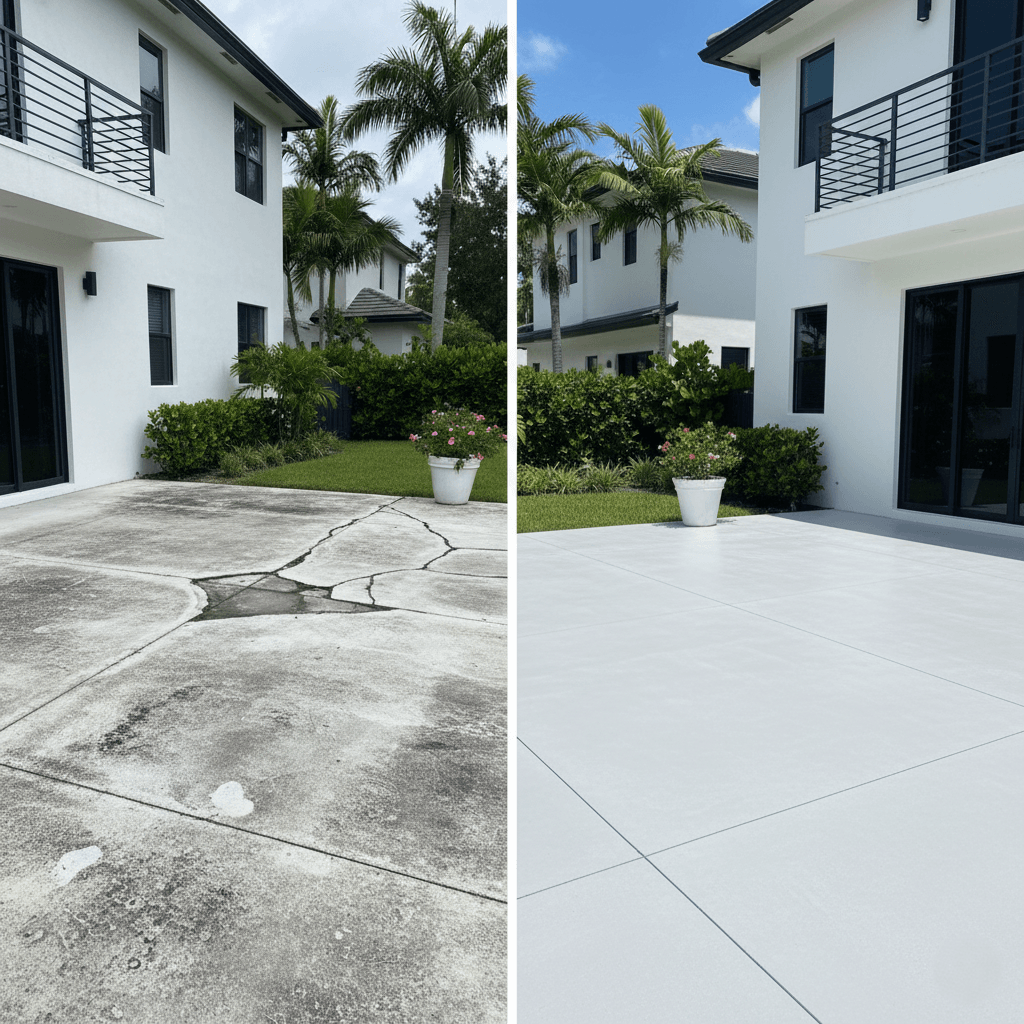
Concrete Repair After Flooding: Do’s & Don’ts in Doral, FL
Concrete Repair Doral
Flooding events in Doral require immediate and informed action to properly assess and repair concrete damage while ensuring safety and long-term structural integrity. South Florida’s vulnerability to hurricanes, tropical storms, and severe weather makes understanding proper concrete repair protocols essential for property owners throughout Miami-Dade County. Floodwaters create unique challenges, including contamination, structural compromise, and accelerated deterioration that demand professional expertise and careful evaluation. Knowing the correct steps to take—and critical mistakes to avoid—can mean the difference between successful restoration and costly failures that compromise safety and property values. Following established guidelines protects both immediate recovery efforts and long-term structural performance in Doral’s challenging climate.

DO: Ensure Safety First and Assess Damage Properly
Before beginning any concrete repair work after flooding, prioritize safety by ensuring electrical systems are properly shut off and structural stability has been verified by qualified professionals. Floodwaters may have compromised foundations, undermined support systems, or created hazardous conditions that aren’t immediately visible. Contact licensed structural engineers to evaluate concrete foundations, slabs, and load-bearing elements before proceeding with repairs.
Document all damage thoroughly with photographs and detailed notes for insurance claims and repair planning. This documentation proves invaluable for both immediate restoration needs and future reference. Properties near Trump National Doral and CityPlace Doral should pay particular attention to soil conditions around concrete structures, as flooding may have caused erosion or settlement that affects structural stability.
Professional Assessment Requirements
Engage certified concrete specialists familiar with post-flood evaluation protocols to assess contamination levels, structural integrity, and appropriate repair methods. Professional assessment identifies hidden damage that could compromise future performance while determining which areas require immediate attention versus those that can await scheduled repairs.
DON’T: Rush Into Repairs Without Proper Evaluation
Avoid immediately patching visible cracks or surface damage without understanding the underlying causes and contamination levels. Floodwater often contains sewage, chemicals, and debris that penetrate concrete pores and create long-term problems if not properly addressed before repairs begin. Surface repairs over contaminated concrete typically fail and may trap harmful substances within the structure.
Never assume that concrete that looks undamaged has escaped harm from flooding. Water infiltration, chemical contamination, and soil movement may have created problems that become apparent only later. Properties throughout Downtown Doral and the surrounding areas should undergo a comprehensive evaluation regardless of visible damage levels.
Hidden Damage Considerations
Floodwaters can undermine foundations, wash away supporting soils, and introduce contaminants deep into concrete structures where they continue causing damage long after the waters recede. Professional evaluation reveals these hidden issues before they become major structural problems.
DO: Address Contamination and Water Removal First
Begin concrete repair processes by addressing contamination from floodwaters, which often contain sewage, chemicals, and organic matter that can cause ongoing deterioration if not properly treated. Use appropriate decontamination procedures, including thorough cleaning with approved antimicrobial solutions and complete drying before attempting any structural repairs.
Remove all standing water and implement comprehensive drying strategies using professional-grade dehumidifiers and air circulation equipment. Moisture trapped within concrete can lead to mold growth, continued deterioration, and failure of repair materials. Monitor moisture levels using professional meters to ensure complete drying before proceeding with restoration work.
Proper Decontamination Protocols
Follow established decontamination procedures that address both surface contamination and penetration into porous concrete. This may require specialized cleaning agents, pressure washing, and antimicrobial treatments applied by certified professionals familiar with post-flood restoration requirements.
DON’T: Ignore Saltwater Damage Implications
Coastal flooding or storm surge in Doral often involves saltwater intrusion that creates aggressive corrosion conditions for reinforcement steel within concrete structures. Saltwater penetration accelerates deterioration processes and requires specialized treatment approaches different from those for freshwater flooding. Never treat saltwater-contaminated concrete the same as structures affected by clean water.
Avoid using standard repair materials and methods on saltwater-damaged concrete without proper assessment of chloride levels and corrosion potential. Saltwater contamination may require the complete removal of affected concrete, specialized corrosion inhibitors, and enhanced protective measures during reconstruction to prevent ongoing deterioration.
Chloride Testing and Treatment
Professional chloride testing determines contamination levels and guides appropriate treatment strategies. High chloride content may necessitate complete removal and replacement rather than surface repairs that won’t address ongoing corrosion issues.
DO: Use Appropriate Materials and Methods
Select repair materials specifically designed for post-flood conditions and Florida’s challenging environment. This includes moisture-resistant compounds, antimicrobial additives, and enhanced adhesion systems that perform reliably in high-humidity conditions. Ensure all materials comply with Florida Building Code requirements and manufacturer specifications for flood-damaged substrates.
Implement proper surface preparation, including removal of loose material, thorough cleaning, and appropriate bonding agents to ensure repair materials adhere properly to existing concrete. Poor surface preparation represents the primary cause of repair failures, particularly in post-flood conditions where contamination and moisture complicate bonding.
Material Selection Criteria
Choose materials with proven performance in South Florida’s climate, including resistance to humidity, temperature cycling, and potential future flooding. Consider using polymer-modified repair compounds that offer enhanced flexibility and moisture resistance compared to traditional cement-based materials.
DON’T: Attempt Complex Structural Repairs Without Professional Help
Avoid attempting repairs to load-bearing elements, foundations, or structurally significant concrete without qualified professional oversight. Post-flood damage often compromises structural integrity in ways that aren’t obvious to untrained observers, making professional engineering assessment essential for safety and code compliance.
Never ignore permit requirements for concrete repair work, particularly after flooding events that may trigger substantial damage thresholds requiring enhanced construction standards. Miami-Dade County enforces strict requirements for post-disaster repairs to ensure structures can withstand future events and protect occupant safety.
Permit and Code Compliance
Understand that flood-damaged properties may be subject to substantial damage rules requiring upgrades to current building standards. Professional contractors familiar with local requirements help navigate these complex regulations while ensuring compliant repairs.
DO: Plan for Enhanced Drainage and Water Management
Incorporate improved drainage systems and water management strategies into concrete repair planning to reduce vulnerability to future flooding. This may include enhanced grading, improved guttering systems, and waterproofing measures that protect repaired concrete from recurring water damage.
Consider installing sump pumps, drainage systems, and moisture barriers as part of comprehensive repair strategies that address both immediate damage and long-term protection. Properties in the Doral Central Park area and other flood-prone locations particularly benefit from enhanced water management systems integrated with concrete repairs.
Future Flood Mitigation
Design repair strategies that not only restore current function but also improve resistance to future flooding through enhanced materials, improved drainage, and elevated critical elements where appropriate and feasible.
DON’T: Rush the Drying and Curing Process
Avoid accelerating drying or curing processes beyond manufacturer recommendations, particularly in Florida’s high-humidity environment. Rapid drying can cause shrinkage cracking and poor material performance, while inadequate curing compromises long-term strength and durability. Allow adequate time for complete moisture removal and proper material curing despite pressure to complete repairs quickly.
Never begin repairs while concrete remains saturated or ambient humidity levels remain elevated from flooding conditions. Trapped moisture prevents proper bonding and can cause repair materials to fail prematurely, requiring costly rework and potentially creating safety hazards.
Curing Environment Control
Control ambient conditions during repair work using dehumidifiers, fans, and temporary shelter to create optimal curing environments. Professional contractors understand how to manage these conditions for successful outcomes in challenging post-flood situations.
DO: Implement Comprehensive Quality Control
Establish thorough quality control procedures, including material testing, adhesion verification, and performance monitoring throughout the repair process. This includes testing repair materials for compatibility with existing concrete, verifying proper mixing and application procedures, and conducting appropriate curing inspections.
Document all repair procedures, materials used, and quality control measures for future reference and warranty purposes. This documentation proves valuable for insurance claims, future maintenance planning, and verification of proper repair procedures if problems arise later.
Testing and Verification Protocols
Implement testing procedures that verify repair quality, including pull-off tests for adhesion, core samples for strength verification, and visual inspections for proper application and curing. Professional oversight ensures these tests are conducted properly and results are interpreted correctly.
DON’T: Neglect Mold and Biological Growth Prevention
Avoid creating conditions that promote mold growth and biological contamination during and after concrete repairs. This includes ensuring complete drying, using antimicrobial treatments where appropriate, and maintaining proper ventilation throughout the repair process. Mold growth can compromise both health and structural integrity while creating ongoing maintenance problems.
Never seal moisture or organic contamination within concrete structures through inadequate cleaning or premature application of impermeable coatings. Trapped moisture and contaminants continue causing problems and may lead to complete repair failure, requiring extensive rework.
Biological Contamination Control
Use appropriate antimicrobial treatments and maintain environmental conditions that prevent biological growth while ensuring these treatments don’t interfere with repair material performance or long-term durability.
DO: Consider Long-term Maintenance and Monitoring
Develop ongoing maintenance and monitoring programs that help detect potential problems before they become major issues. This includes regular inspections for signs of deterioration, moisture intrusion, or repair failure, particularly during the first few years after flood damage and repair.
Plan for enhanced protective measures, including sealers, coatings, and drainage maintenance that help preserve repaired concrete and reduce vulnerability to future damage. Regular maintenance proves far more cost-effective than emergency repairs and helps ensure long-term structural integrity.
Preventive Maintenance Strategies
Establish inspection schedules and maintenance protocols that account for South Florida’s challenging climate while monitoring repair performance over time. Early detection of problems allows for minor interventions rather than major reconstructive work.
Professional Resources and Support
Work with qualified professionals who understand post-flood concrete repair challenges specific to South Florida’s environment and regulatory requirements. This includes structural engineers, certified concrete contractors, and restoration specialists with proven experience in flood damage recovery.
Coordinate with insurance professionals, permitting authorities, and utility companies as needed to ensure comprehensive recovery that addresses all aspects of flood damage while maintaining compliance with applicable codes and standards.
At Doral Concrete Works, we provide expert concrete repair services specifically designed for post-flood conditions in South Florida. Our experience with local flooding challenges, building codes, and environmental factors ensures proper assessment, safe procedures, and durable repairs that protect your property investment while meeting all regulatory requirements for successful recovery.



